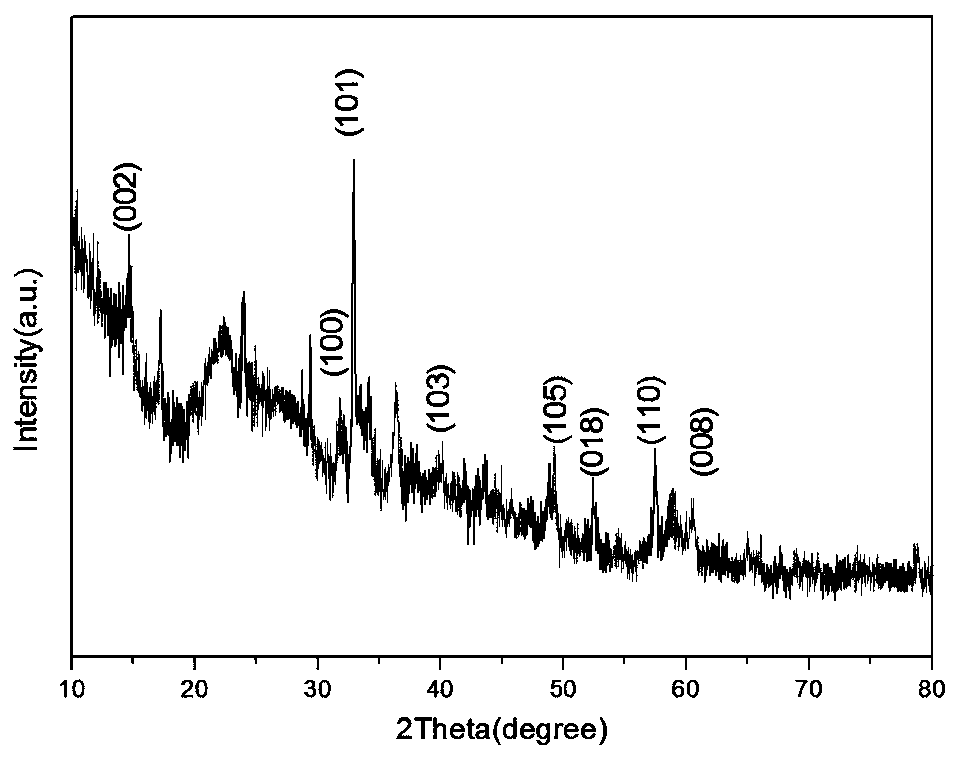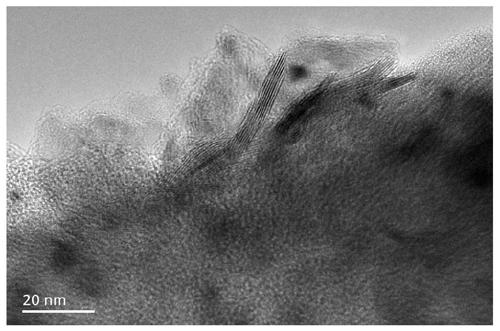A kind of photocatalytic composite material and its preparation method and application
A composite material and photocatalysis technology, which is applied in the field of photocatalytic composite materials and its preparation, can solve the problems of limiting the application of transition metal sulfide semiconductor materials, high cost of hydrogen production, and large power consumption
- Summary
- Abstract
- Description
- Claims
- Application Information
AI Technical Summary
Problems solved by technology
Method used
Image
Examples
preparation example Construction
[0024] The present invention provides a method for preparing a photocatalytic composite material, which includes the following steps:
[0025] (1) The plant leaves are pretreated by soaking to obtain template biomass;
[0026] (2) Immerse the template biomass obtained in step (1) in the molybdenum source-sulfur source aqueous solution, and obtain a composite material precursor after immersion;
[0027] (3) calcining the composite material precursor obtained in step (2) to obtain a photocatalytic composite material.
[0028] In the present invention, plant leaves are soaked and pretreated to obtain template biomass. The present invention does not specifically limit the types of the plant leaves, and those skilled in the art can use plant leaves that are well known to those skilled in the art, specifically, such as arrow bamboo leaves, willow leaves, bamboo leaves, golden bamboo leaves or purple bamboo leaves.
[0029] In the present invention, the soaking pretreatment preferably include...
Embodiment 1
[0043] A preparation method of photocatalytic composite material:
[0044] (1) Pre-soaking the golden bamboo leaves to obtain template biomass;
[0045] (2) After mixing 200 mL of a molybdenum source-sulfur source aqueous solution with a sodium molybdate concentration of 0.05 mol / L and a thiourea concentration of 0.10 mol / L with the above-mentioned 10 g of template biomass, the mixture was immersed at 25°C for 72 hours, and the impregnated product was taken out , After washing and drying in turn, the composite material precursor is obtained;
[0046] (3) In a nitrogen atmosphere, the temperature is increased to 700°C at a heating rate of 3°C / min, calcined for 120 minutes, and naturally cooled to room temperature to obtain a photocatalytic composite material.
[0047] The pretreatment of golden bamboo leaves soaking includes: (a) the golden bamboo leaves are mixed with the first agent (dilute hydrochloric acid with a mass concentration of 5% and anhydrous ethanol in a volume ratio of 3...
Embodiment 2
[0054] A preparation method of photocatalytic composite material:
[0055] (1) The willow leaves are soaked and pretreated to obtain template biomass;
[0056] (2) After mixing 120 mL of a molybdenum source-sulfur source aqueous solution with a concentration of ammonium molybdate of 0.10 mol / L and a concentration of sodium sulfide of 0.20 mol / L with the above 5 g of template biomass, immerse at 27°C for 72 hours, and take out the impregnated product , After washing and drying in turn, the composite material precursor is obtained;
[0057] (3) In a nitrogen atmosphere, heat up to 500°C at a heating rate of 3°C / min, calcinate for 150 minutes, and naturally cool to room temperature to obtain a photocatalytic composite material.
[0058] The soaking pretreatment method of the willow leaves is the same as the soaking pretreatment parameters of the golden bamboo leaves in Example 1.
[0059] Applying the photocatalytic composite material prepared in this embodiment to splitting water to prod...
PUM
 Login to View More
Login to View More Abstract
Description
Claims
Application Information
 Login to View More
Login to View More - R&D
- Intellectual Property
- Life Sciences
- Materials
- Tech Scout
- Unparalleled Data Quality
- Higher Quality Content
- 60% Fewer Hallucinations
Browse by: Latest US Patents, China's latest patents, Technical Efficacy Thesaurus, Application Domain, Technology Topic, Popular Technical Reports.
© 2025 PatSnap. All rights reserved.Legal|Privacy policy|Modern Slavery Act Transparency Statement|Sitemap|About US| Contact US: help@patsnap.com



